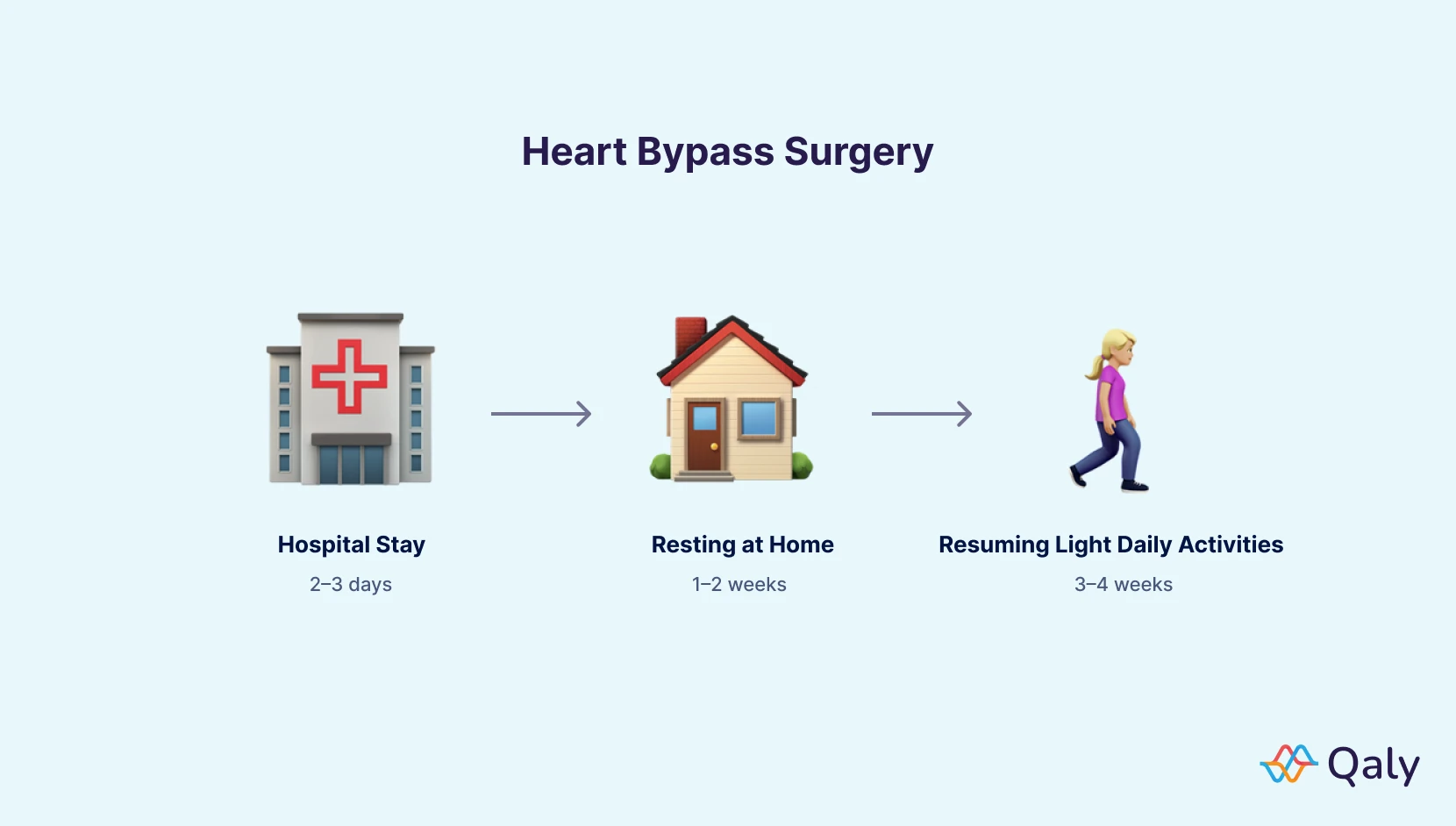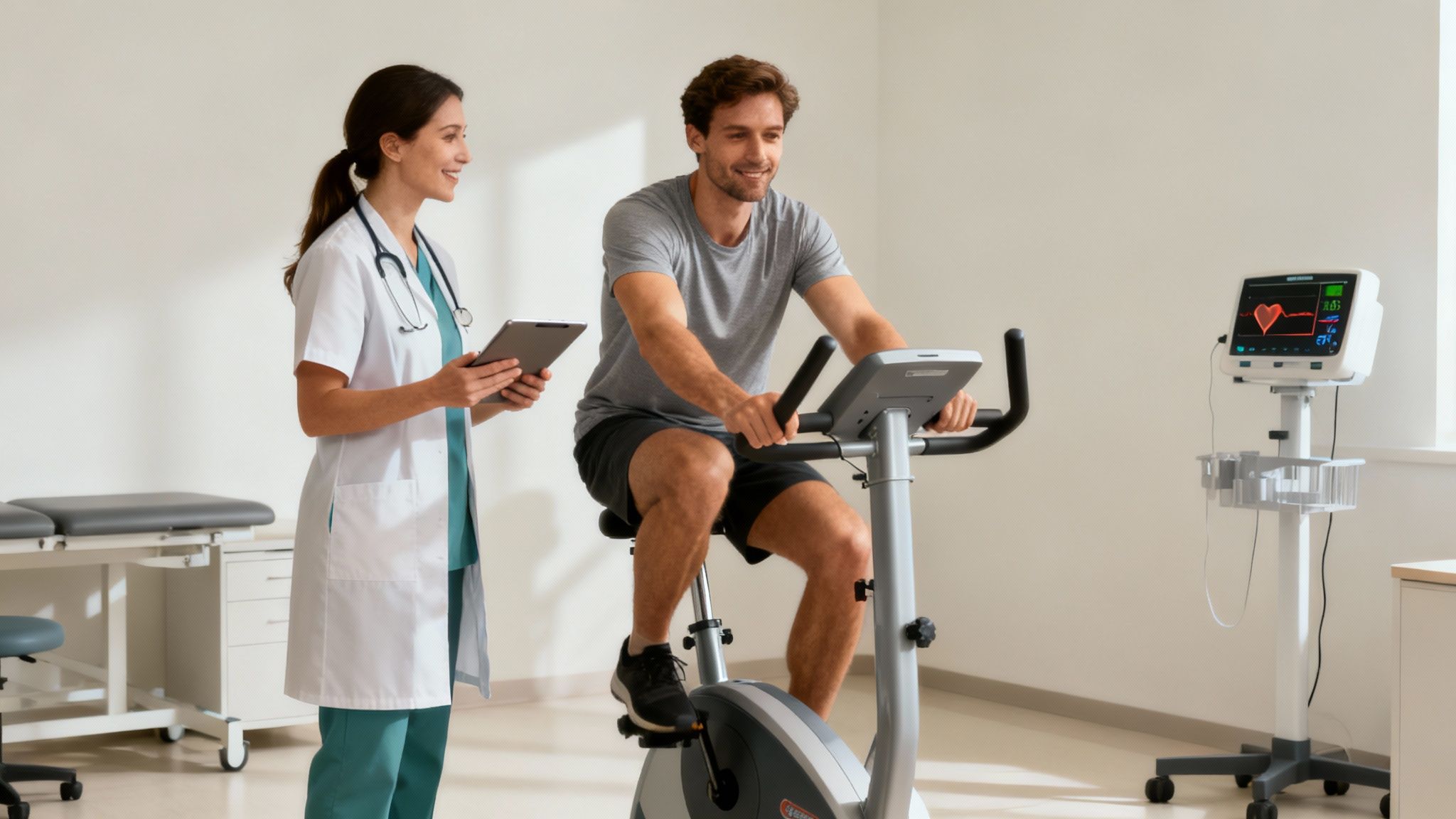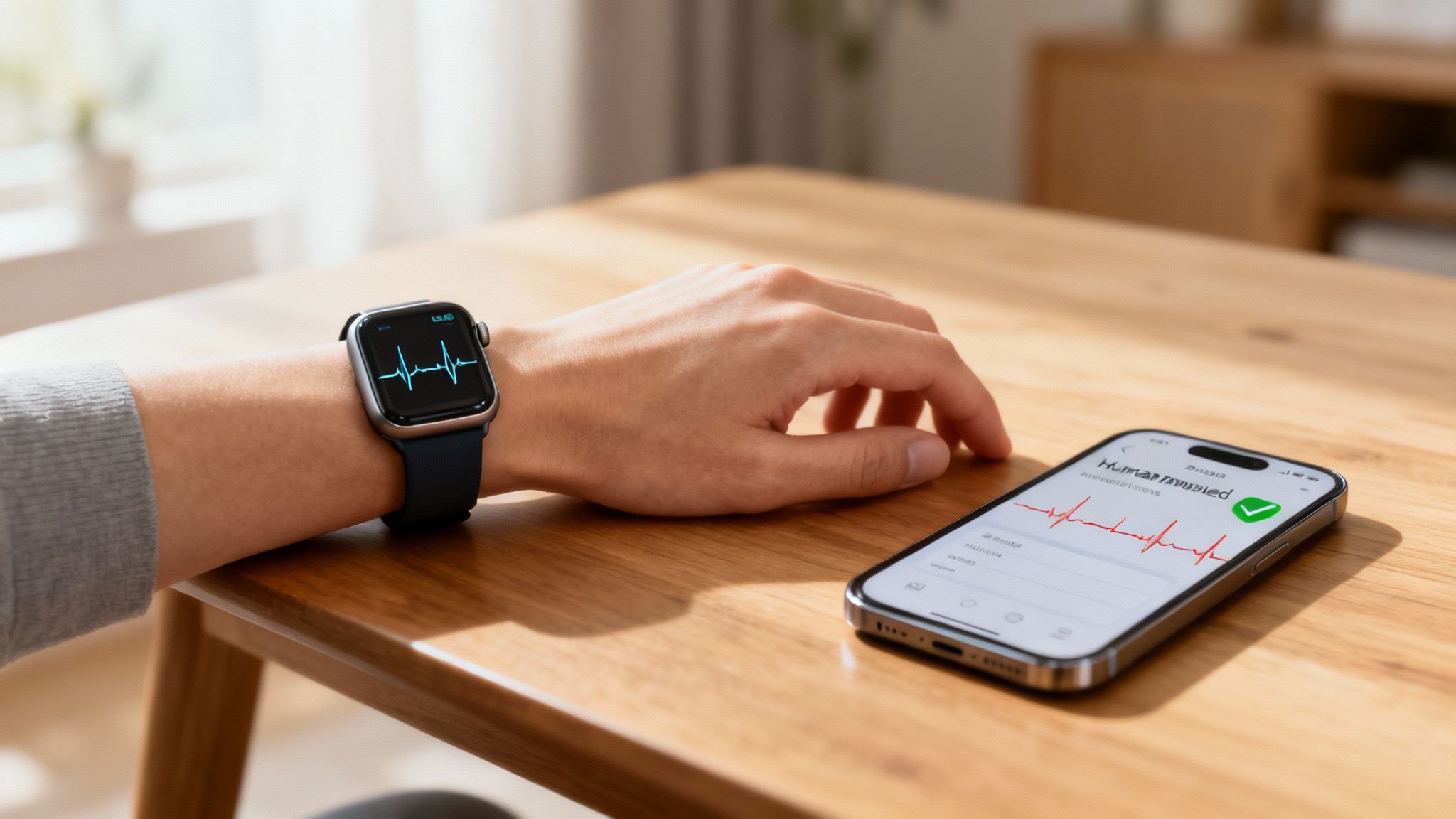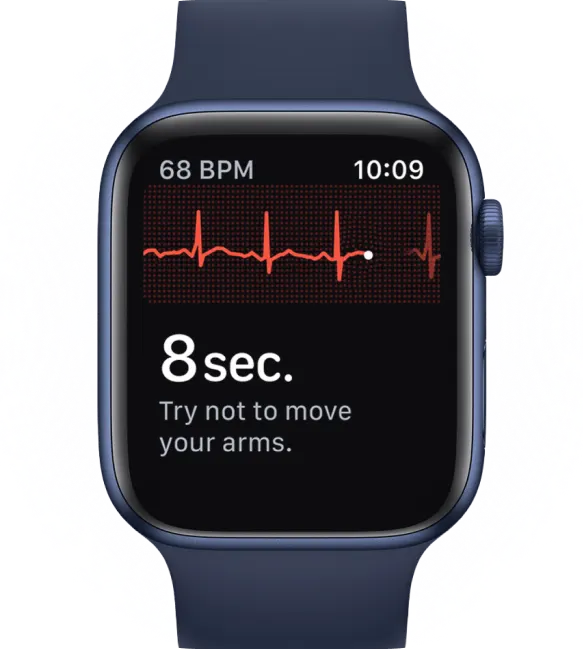Key Takeaways
Hello, heart hero. Your recovery journey starts right now.
Recovering from heart bypass surgery is a step-by-step process that begins in the hospital and continues for many weeks once you’re back home. While it’s certainly a major operation, the whole point is to help you get your strength back and, ultimately, improve your quality of life. Right after surgery, you’ll spend 1 to 2 days in the intensive care unit (ICU), then move to a regular hospital room for a few more days before heading home to heal.
Your Guide to a Confident Recovery
We get it. The road ahead can feel a bit foggy, especially when you’re navigating a healthcare system that sometimes feels impersonal. Think of this guide as a friend in your corner, written in simple, clear language to help you feel in control. We'll walk you through every stage of your recovery, from those first few days in the hospital to the new, healthier life you'll build in the coming months.
Our goal here is to give you practical, reassuring information, treating you like the courageous person you are, not just another patient file.
What You'll Learn Here
This guide is built to be your go-to resource for regaining both your strength and your confidence. We’ll cover the essentials to support you, including:
- How to manage pain and take care of your incision to help it heal properly.
- Navigating the emotional ups and downs that are a completely normal part of this journey.
- Making healthy lifestyle choices that actually stick and protect your heart for the long haul.
Heart bypass surgery, or Coronary Artery Bypass Grafting (CABG), is a common and highly successful procedure with a well-defined recovery path. The survival rate immediately following the surgery is around 97-98%, which shows just how effective it is at treating severe blockages in the coronary arteries.
Try to think of the next few weeks and months not just as "recovery," but as a real opportunity to build a stronger, healthier future for yourself. We're here to help you navigate it with confidence.
What to Expect in the First Six Weeks
The first six weeks after your operation are the most critical for your physical healing. Think of this period as laying the foundation for the rest of your life. It’s a time for patience, listening to what your body tells you, and celebrating the small victories along the way.
We know it can feel daunting, but understanding what’s coming can make all the difference. Your body has been through a lot, and now it’s time to give it the support it needs to mend properly.
This visual timeline gives you a great overview of the key phases of your recovery, from your hospital stay to getting back to a more active life.

As the infographic shows, recovery is a progressive journey. It moves from intensive medical care to self-managed healing at home and, finally, to long-term health maintenance.
For a clearer picture, here is a breakdown of what you can generally expect during the early stages of your recovery.
Heart Bypass Surgery Recovery Timeline At a Glance
Recovery Phase: The Hospital Stay
- Typical Duration: 2 to 3 Days
- Key Focus and Activities: Close monitoring in the ICU, followed by gentle movement like sitting in a chair and short walks in the hallway.
Recovery Phase: Weeks 1 to 2 at Home
- Typical Duration: 1 to 2 Weeks
- Key Focus and Activities: Resting, managing pain, caring for incisions, and taking very short, slow walks inside the house.
Recovery Phase: Weeks 3 to 6 at Home
- Typical Duration: 3 to 4 Weeks
- Key Focus and Activities: Gradually increasing walking distance and time. Resuming light daily activities while strictly following lifting restrictions.
Remember, this is a general timeline, and everyone's personal journey will be slightly different.
Your First Few Days: The Hospital Stay
Your recovery begins the moment you wake up from surgery. You’ll start in the Intensive Care Unit (ICU), where a dedicated team will monitor you very closely for the first day or two. This is standard procedure to ensure you’re stable and safe.
Once you're stable, you’ll be moved to a regular hospital room. Here, the focus shifts from intensive monitoring to actively starting your recovery. Nurses will help you manage any pain and encourage you to take your first, gentle steps.
Getting out of bed and walking a little, even just to a nearby chair or down the hall, is a huge milestone. It’s vital for preventing complications like blood clots and pneumonia and really kickstarts your body's healing process.
Weeks 1-2: Coming Home and Settling In
Going home is a big step, and it’s completely normal to feel a mix of excitement and nervousness. Your main jobs during these first two weeks are simple: rest, manage your pain, and take care of your incisions.
It’s crucial to keep your incision sites clean and dry, and your care team will give you specific instructions on how to do this. Be sure to watch for any signs of infection, such as increased redness, swelling, or drainage. While some discomfort is normal, knowing what to look out for empowers you to act quickly if something seems off. For more details, check out our guide on navigating post-heart surgery complications.
During this time, your main physical activity will be short, slow walks inside your home. The goal isn’t to push yourself but to gently reintroduce movement into your day.
Weeks 3-6: Building Strength and Stamina
As you move into the third week and beyond, you’ll likely start to feel a bit stronger each day. This is when you can begin to slowly increase your activity level, but it’s absolutely vital to follow your doctor’s specific guidelines.
- Walking: Aim to walk a little farther or for a few more minutes each day. Walking outside on a flat, even surface is a great way to build up your stamina.
- Daily Activities: You can gradually get back to light household tasks, like dusting or preparing simple meals. Just be sure to avoid anything that causes you to strain.
- Listen to Your Body: Fatigue is your body’s signal to rest. Don’t be afraid to take naps or schedule quiet time. Pushing yourself too hard right now can actually set your recovery back.
A key rule during this entire six-week period is protecting your breastbone (sternum). It was divided during the surgery and needs about six to eight weeks to heal fully, much like a broken bone.
To protect your sternum, you must avoid certain movements without exception.
Understanding Lifting and Movement Restrictions
This is one of the most important parts of your early recovery. Straining your chest muscles can seriously interfere with how your breastbone heals.
For the first six weeks, you should strictly follow these rules:
- No Lifting: Do not lift anything heavier than 5-10 pounds. That’s about the weight of a gallon of milk.
- No Pushing or Pulling: This means avoiding activities like vacuuming, mowing the lawn, or moving furniture.
- Use Both Arms: When you get up from a chair or bed, avoid pushing up with just one arm. Try to use your legs to do the work or ask for assistance.
These restrictions are temporary but absolutely essential. Following them carefully gives your body the best possible chance to heal correctly, setting you up for a strong and successful long-term recovery.
Building a Stronger Heart After Surgery

A true recovery from heart bypass surgery goes way beyond just healing your incision. It's about building a stronger, more resilient heart for the years to come. This is the part of your journey where you really take back control, and it all comes down to two powerful pillars: cardiac rehabilitation and lasting lifestyle changes.
Think of it this way: the surgery fixed the immediate plumbing problem, but now it’s time to strengthen the whole system. This is your chance to give your heart the support it’s been needing.
The Power of Cardiac Rehabilitation
The term "cardiac rehab" might sound a little intimidating, but it’s honestly one of the most supportive and empowering parts of your recovery. It's a medically supervised program designed to help you get your strength, confidence, and heart health back on track in a safe, structured way.
Lots of people are a bit hesitant to join a formal program, but the benefits are just too big to ignore. Study after study has shown that patients who complete cardiac rehab have a much lower risk of future heart problems and simply enjoy a better quality of life.
A typical cardiac rehab program is a team effort, bringing together you, your doctors, nurses, exercise specialists, and dietitians. It’s built around three key pieces:
- Monitored Exercise: You’ll begin with gentle, supervised exercise that's specifically designed for you. This helps you safely rebuild your physical strength and stamina without pushing too hard, too soon.
- Education for Heart-Healthy Living: You’ll get practical, real-world information on nutrition, managing medications, and understanding your heart condition. No confusing medical jargon, just useful advice.
- Counseling to Reduce Stress: This part helps you manage stress and deal with the emotional side of recovery, which is every bit as important as the physical side.
Cardiac rehab isn’t just about treadmills and heart monitors. It's a support system that teaches you how to listen to your body and trust it again, giving you the tools and confidence to live a full, active life.
Most programs start a few weeks after you get home from the hospital. Your cardiologist will give you a referral when they feel you're ready. While these programs are invaluable, you can also support your progress with safe activities at home. For some ideas to run by your doctor, check out our guide on cardiac rehab exercises at home.
Making Small Changes for a Big Impact
Beyond a structured rehab program, your daily habits play a massive role in your heart's long-term health. The goal isn't to flip your entire life upside down overnight. It's all about making small, sustainable changes that add up to a huge difference over time.
Think of it like building a strong wall, one brick at a time. Every healthy choice you make is another brick reinforcing your heart's defenses.
Practical Steps for a Heart-Healthy Lifestyle
Let’s zero in on a few key areas where you can make a real difference.
1. Embrace Heart-Healthy Eating
This doesn't mean your food has to be boring. Not at all. It’s about choosing foods that truly nourish your heart. Try to add more fruits, vegetables, whole grains, lean proteins like fish and chicken, and healthy fats from things like avocados and nuts. At the same time, work on cutting back on sodium, saturated fats, and processed sugars.
2. Quit Smoking for Good
If you smoke, quitting is the single most powerful thing you can do for your heart. Smoking damages your blood vessels and can literally undo all the benefits of your surgery. There are so many resources out there to help you, so talk to your doctor about finding a plan that works for you.
3. Manage Your Blood Pressure
High blood pressure puts extra strain on your heart and arteries. Your doctor will likely prescribe medication, but your lifestyle can make a world of difference. Cutting back on salt, exercising regularly, and managing stress are all proven ways to help keep your blood pressure in a healthy range.
Remember, making these changes is a journey, not a race. Be kind to yourself, celebrate the small wins, and know that every step forward is a victory for your heart.
Understanding Your New Medications
Coming home with a bag full of new prescriptions can feel like you need a secret decoder ring just to keep everything straight. It's totally normal to feel a bit overwhelmed by it all.
Think of these new medications as your personal support team, working around the clock to protect your heart and the incredible work your surgeon just performed. This isn't just about swallowing pills; it's about understanding why each one is a vital piece of your recovery puzzle.
The surgery bypassed the blockages, but it didn't cure the underlying condition that caused them in the first place. That's where these medications step in, teaming up with your new lifestyle habits to build a long-term defense for your heart.
Your New Daily Regimen Explained
Every medication you've been prescribed has a very specific job. While your exact list is tailored to you, it will almost certainly include a few key players that are standard after bypass surgery. Let's break down what the most common ones do in simple terms.
- Blood Thinners (Anticoagulants/Antiplatelets): Your new bypass grafts are like brand-new, clean pipes. Medications like aspirin or clopidogrel make your blood less "sticky," which helps prevent dangerous blood clots from forming inside them. This keeps the blood flowing freely, right where it needs to go.
- Beta-Blockers: These are the guardians of your heart's workload. They gently lower your blood pressure and slow your heart rate, which means your heart doesn't have to work so hard while it's healing. Think of it as giving your heart muscle a much-needed vacation. You can learn more about how beta-blockers affect your heart in our detailed guide.
- Statins: These are your cholesterol-lowering champions. High levels of "bad" (LDL) cholesterol are what contribute to the plaque buildup that caused the blockages. Statins are essential for keeping your arteries, including your new grafts, clear and healthy for the long haul.
It’s also worth mentioning that the success of these medications is linked to the quality of the surgery itself. A big part of your recovery depends on the type of grafts used. While veins from the leg were once common, surgeons now frequently use arteries from the chest or arm. These arterial grafts have proven to be much more durable over the long term, meaning they're less likely to get blocked again. This gives your new medications the best possible foundation to work with.
Tips for Managing Your Medications
Feeling confident about your medication schedule is a huge step toward a smooth recovery. Here are a few practical tips to help you stay on track and feel in control.
The most important rule is to never stop taking a medication without talking to your doctor first. Suddenly stopping certain heart medications can have serious consequences. Always keep your care team in the loop about any concerns you have.
Creating a Routine:
- Use a Pill Organizer: A simple weekly pill box can be a lifesaver. Fill it up once a week, and you’ll always know at a glance if you've taken your daily doses.
- Set Alarms: Use your phone or a smartwatch to set daily reminders for each medication time. A little nudge can make all the difference.
- Link It to a Habit: Try taking your pills with the same daily activity, like right after brushing your teeth in the morning or just after you finish dinner.
It's also smart to be aware of potential side effects, but try not to worry unnecessarily. Your doctor will have gone over the most common ones with you. A great idea is to keep a simple log of any new symptoms you experience and share it with your doctor at your follow-up visits. This teamwork approach ensures your medication plan is perfectly suited for you, helping you thrive for years to come.
Navigating the Emotional Side of Recovery
Your physical healing is a massive part of recovering from heart bypass surgery, but it's only half the story. Just as important is your emotional wellbeing, and it’s something we need to talk about openly. Going through a major operation like this can feel like an emotional rollercoaster, and it’s completely normal to feel a whole range of things as you heal.
Many people are taken by surprise by the emotional ups and downs that follow surgery. One minute you might feel grateful and hopeful, and the next you could feel anxious, irritable, or just plain fragile. This is so common that it has a name: the "cardiac blues."
Let me be clear: these feelings are not a sign of weakness. They are a completely normal response to what your body and mind have just endured. The first step is simply acknowledging these emotions and allowing them to be there.
Understanding the Cardiac Blues
The cardiac blues can look different for everyone. For some, it's a general feeling of being down. For others, it might mean being more tearful than usual, or finding it hard to sleep or concentrate. You might find yourself worrying about the future or feeling a sense of vulnerability you've never felt before.
These feelings often bubble up from the stress of the surgery itself, the physical discomfort of recovery, and the major life changes you’re processing. It's crucial to know you are far from alone in this. Up to 1 in 5 people experience significant depressive symptoms after bypass surgery.
The most compassionate thing you can do for yourself right now is to be patient. Your heart is mending, and your mind and spirit need time to catch up. Give yourself permission to feel whatever you’re feeling without judgment.
Just recognizing that these emotional shifts are a normal part of the process can take away some of their power. It helps you see this as a temporary phase, not a permanent new reality.
Practical Ways to Support Your Emotional Health
While you can't just wish these feelings away, there are simple, practical things you can do to support yourself emotionally. It’s all about finding small ways to bring comfort, connection, and a sense of control back into your day.
- Talk About It: Don't try to tough it out alone. Sharing what you're going through with a trusted family member, a good friend, or someone on your medical team can make a huge difference. Sometimes, just saying your worries out loud can lighten the load.
- Stay Gently Active: As you get stronger, gentle movement like short walks can be incredibly powerful. Exercise releases endorphins, your body's natural mood-lifters, and getting outside for a bit of fresh air and sunshine can do wonders for your spirits.
- Celebrate Small Victories: Did you walk a little farther today? Did you enjoy a peaceful cup of coffee? Acknowledge these small wins. Celebrating your progress, no matter how small it seems, helps shift your focus toward healing and hope.
Worry and anxiety are common companions during recovery. Exploring strategies to stop worrying and calm your mind can be incredibly helpful. Learning a few simple breathing techniques can give you a powerful tool to stay grounded when anxiety starts to creep in.
Finding your 'new normal' takes time. Be kind to yourself, lean on your support system, and remember that this journey is all about rediscovering your strength, one day at a time.
How to Monitor Your Heart Health at Home

Taking charge of your own health after surgery can bring a huge amount of peace of mind. When the healthcare system can feel a little distant, having simple tools to keep an eye on your heart at home makes a real difference. This isn't about creating new things to worry about; it’s about gathering good, solid information you can share confidently with your doctor.
Many of us already wear a smartwatch or other wearable device. These gadgets are great for tracking your daily activity and heart rate. That data gives you and your doctor a starting point, a baseline to see how your heart is handling the gradual return to activity during your heart bypass surgery recovery.
Understanding Your Heart's Rhythm
One of the most powerful tools on many smartwatches today is the ability to take an electrocardiogram, or ECG. You can think of an ECG as a quick snapshot of your heart's electrical activity. It shows exactly how your heart is beating at that moment.
After major surgery, your heart is in a delicate healing phase, and it's not uncommon for rhythm changes to pop up. A common one to watch for is Atrial Fibrillation (AFib), which is an irregular and often fast heart rate. Being able to spot potential changes early on gives you something concrete to discuss with your cardiologist. For a deeper dive, it might be helpful to read about the different ways you can check your heart health at home.
Getting Expert Eyes on Your ECG
So, you've taken an ECG on your watch. That part's easy. But understanding what those squiggly lines actually mean? That can feel like a totally different ballgame. This is where getting a bit of backup can be incredibly reassuring.
Having a certified expert review your smartwatch ECG gives you a reliable report to share with your cardiologist. It transforms a piece of data into a clear piece of information, helping you have more productive and confident conversations about your recovery.
This is exactly what a service like Qaly was built for. Anytime you feel like something is off, you can take an ECG on your watch. A team of certified cardiac technicians then reviews it for you, often within minutes. They're trained to analyze the reading for over 30 different heart arrhythmias and send you back a detailed, easy-to-understand report.
This process gives you a trusted, human-reviewed analysis to bring to your next appointment. It closes the gap between the technology on your wrist and the medical expertise you rely on, giving you one more powerful tool to feel secure and proactive on your journey back to a stronger heart.
Your Questions About Recovery Answered
As you find your footing on the path to recovery after heart bypass surgery, it's completely normal for questions to bubble up. Feeling a bit uncertain about what’s around the corner is part of the journey, but getting clear, straight-up answers can make all the difference in feeling confident and in control.
Let's walk through some of the big questions people often have as they ease back into their routines.
Answering Your Key Concerns
Here are a few common milestones many people wonder about, along with some practical advice to help you navigate them.
- When can I go back to work? This really boils down to the kind of work you do. If you have a desk job, you might be looking at a return in about 6 to 8 weeks. For a more physically demanding job, you're likely looking at something closer to three months. Your doctor will always have the final say and give you the green light.
- When is it safe to drive again? You'll need to hit the brakes on driving until your breastbone (sternum) is healing well, which is typically around 4 to 6 weeks post-op. It's not just about the bone; your concentration and reaction time need to be back to 100%, and you absolutely must be off any strong pain medications.
- What about being intimate? Most people can safely resume sexual activity when they feel up to it. A good rule of thumb is when you can climb two flights of stairs without feeling overly tired or out of breath. The main thing is to listen to your body and choose positions that don’t put any pressure on your chest.
While everyone's recovery is their own, it can be reassuring to look at the bigger picture. In-depth studies confirm that bypass surgery is a durable, life-changing procedure for most. For perspective, the in-hospital mortality rate is incredibly low, around 1.62%. The surgery provides many years of improved quality of life for the vast majority of patients. You can read the full research about long-term patient outcomes to see the data for yourself.
The most important thing is to have open, honest conversations with your partner and your healthcare team, and always, always listen to what your body is telling you.
With Qaly, you can get human-reviewed analyses of your smartwatch ECGs in minutes, giving you clear, actionable insights to bring to your next check-up.










.png)
.png)